A mass for asymptotically complex hyperbolic manifolds
A mass for asymptotically complex hyperbolic manifolds
A mass for asymptotically complex hyperbolic manifolds
You also want an ePaper? Increase the reach of your titles
YUMPU automatically turns print PDFs into web optimized ePapers that Google loves.
hal-00429306, version 1 - 2 Nov 2009<br />
A MASS FOR ASYMPTOTICALLY COMPLEX HYPERBOLIC MANIFOLDS. 19<br />
spinor in the chart Ψ1, then φ2 := f∗φ1 is a Kählerian Killing spinor in the chart Ψ2<br />
(by naturality). We claim that<br />
Lemma 3.8 — µ Ψ1<br />
g<br />
(βφ1 ) = µΨ2 g (βφ2 ).<br />
Proof. Recall that in the notations introduced in the previous paragraph,<br />
µ Ψ1<br />
<br />
<br />
g (βφ1 ) = lim<br />
R→∞<br />
∗ζφ1,φ1 = lim<br />
R→∞<br />
∗ζψ1,ψ1 .<br />
This quantity is equal to the well-defined integral<br />
<br />
<br />
<br />
M<br />
ˆ <br />
<br />
∇ψ1<br />
2<br />
+ 1<br />
<br />
(Scal+4m(m + 1)) |ψ1|<br />
4 M<br />
2<br />
<br />
+(m + 1) |ψ1| 2 − <br />
Ω<br />
πl−1ψ1 2 − <br />
Ω<br />
πl ψ1<br />
2 ,<br />
M<br />
S Ψ 1<br />
R<br />
so that we can compute it with another family of spheres :<br />
µ Ψ1<br />
<br />
<br />
g (βφ1 ) = lim<br />
= lim<br />
R→∞<br />
R→∞<br />
R→∞<br />
S Ψ ∗g0<br />
2<br />
R<br />
f(S Ψ ∗ζψ1,ψ1<br />
1<br />
R )<br />
S Ψ 1<br />
R<br />
f(S Ψ ∗ζφ1,φ1<br />
1<br />
R )<br />
.<br />
Since f ∗g0 = g0 and f(S Ψ1<br />
R ) = SΨ2<br />
R , we there<strong>for</strong>e obtain<br />
µ Ψ1<br />
<br />
g (βφ1 ) = lim<br />
R→∞ f(S Ψ <br />
∗g0 −<br />
1<br />
R )<br />
1<br />
2 1<br />
(dTrg0 g + divg0 g) |φ1| + g0 4 8 Trg0 (g − g0) d |φ1| 2<br />
<br />
g0<br />
<br />
= lim − 1<br />
= lim<br />
R→∞<br />
<br />
S Ψ 2<br />
R<br />
= µ Ψ2<br />
g (βφ2 ).<br />
∗g0<br />
4 (dTrg0 g + divg0 g) |f ∗ φ2| 2<br />
g0<br />
+ 1<br />
8 Trg0 (g − g0) d |f ∗ φ2| 2<br />
g0<br />
<br />
− 1<br />
2 1<br />
(dTrg0 g + divg0 g) |φ2| + g0 4 8 Trg0 (g − g0) d |φ2| 2<br />
g0<br />
In other words, changing the chart at infinity by an automorphism f ∈ PU(m,1)<br />
results in turning µg to f ∗ µg. So µg is well-defined up to the natural action of PU(m,1).<br />
We have proved the following result.<br />
Theorem 3.9 — Let (Mm ,g,J) be a spin <strong>asymptotically</strong> <strong>complex</strong> <strong>hyperbolic</strong> Kähler<br />
manifold with odd <strong>complex</strong> dimension Scalg ≥ ScalCHm. Then the linear functional µg<br />
on NCHm ,0 is well-defined up to the natural action of PU(m,1) ; it is non-negative on<br />
N +<br />
CHm ,0 and vanishes if and only if (Mm ,g,J) is the <strong>complex</strong> <strong>hyperbolic</strong> space.<br />
4. The case of even-dimensional <strong>manifolds</strong>.<br />
4.1. The twisted Kählerian Killing spinors. To extend the ideas above to the evendimensional<br />
case, it seems that we need Kählerian Killing spinors on even-dimensional<br />
<strong>complex</strong> <strong>hyperbolic</strong> spaces. Un<strong>for</strong>tunately, such Kählerian Killing spinors do not exist.<br />
To overcome this cruel reality, we follow [BH] and turn to the spin c realm. We refer to<br />
[LM] <strong>for</strong> basic definitions about spin c structures.<br />
We consider a Kähler manifold (M,g,J) with even <strong>complex</strong> dimension m = 2l. As<br />
in [BH], we further assume that the cohomology class of Ω is integral, i.e. in the image<br />
iπ<br />
of H2 (M, Z) → H2 (M, R). This determines a <strong>complex</strong> line bundle L endowed with a<br />
Hermitian metric and a unitary connection with curvature F = −2iΩ ; the Chern class<br />
<br />
<br />
<br />
.


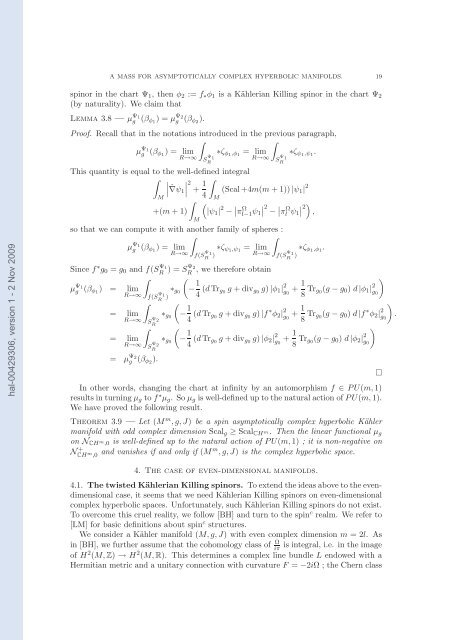

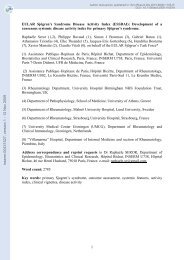
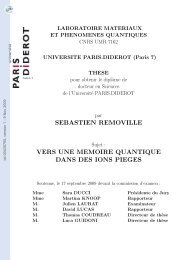
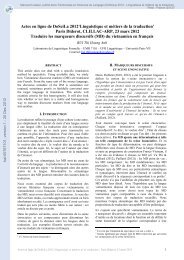
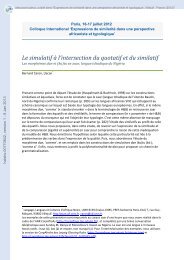
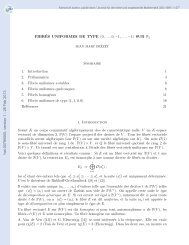
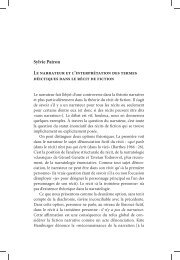
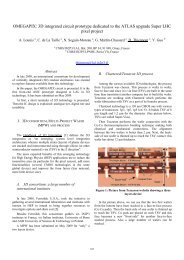
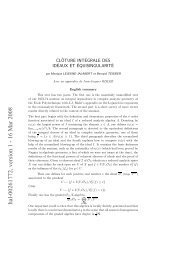
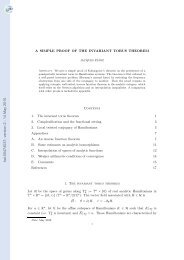

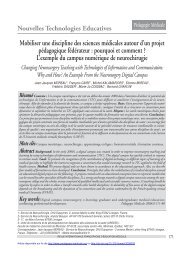

![[tel-00433556, v1] Relation entre Stress Oxydant et Homéostasie ...](https://img.yumpu.com/19233319/1/184x260/tel-00433556-v1-relation-entre-stress-oxydant-et-homeostasie-.jpg?quality=85)